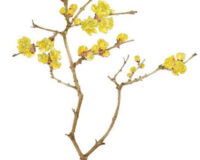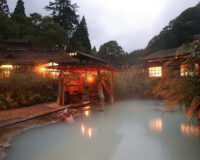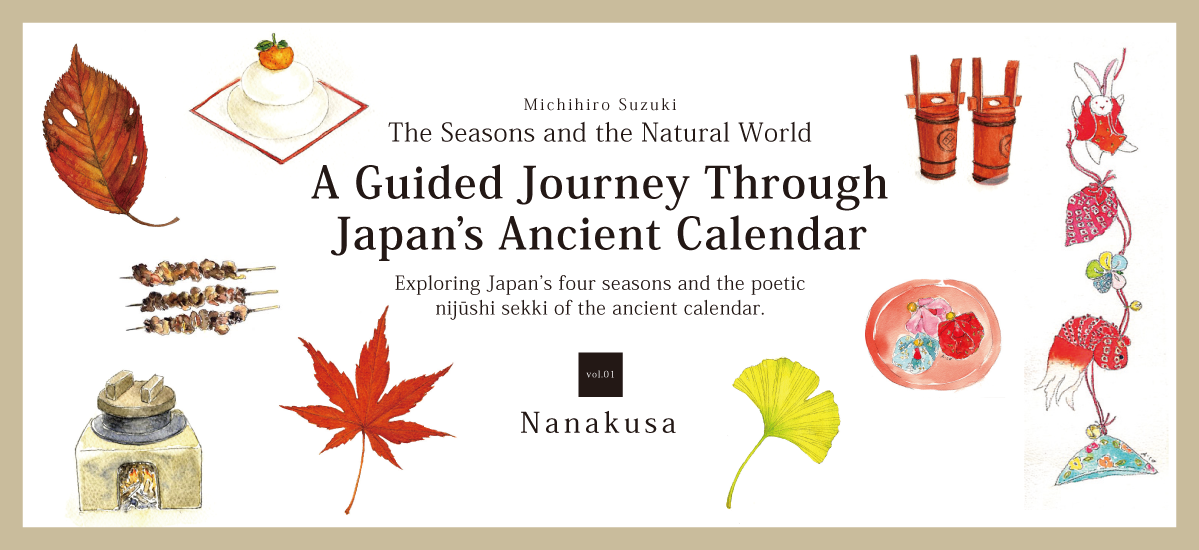
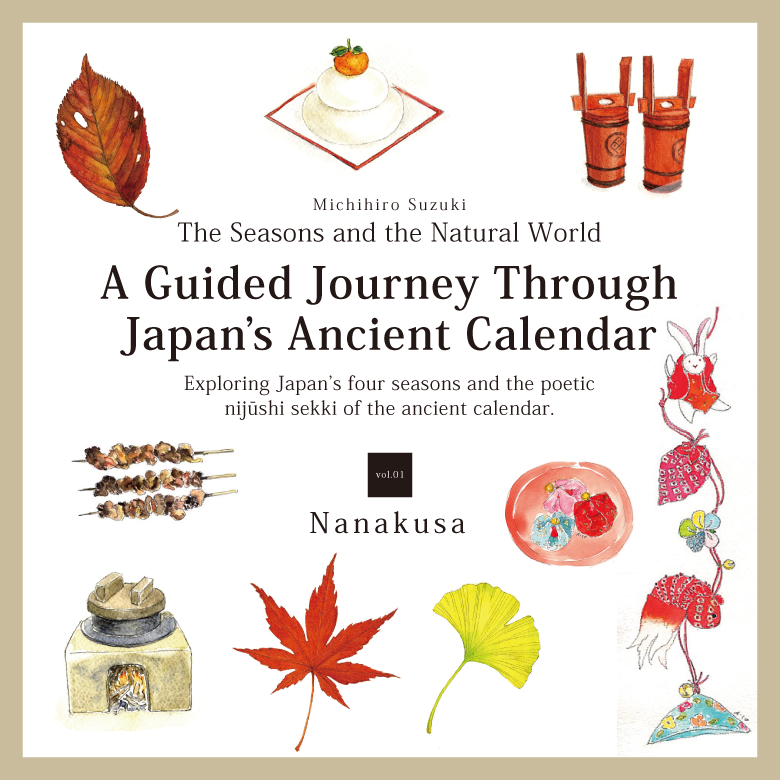
We explore the four seasons in Japan and the poetic nijūshi sekki (twenty-four seasonal divisions) of Japan’s ancient calendar, expressed in the waxing and waning of the moon and the movement of the sun across our skies.
Text : 鈴木充広 Michihiro Suzuki / Illustrations : Aso Yuriko / English Version : Judy Evans
Keyword : Japan’s Ancient Calendar / Nanakusa / Yamanoue no Okura / Japanese poetry / Japan's Ancient Calendar Series
Vol.01 Nanakusa – The Seven Herbs
Aki no no ni sakitaru hana wo oyobiori kakikazoureba nanakusa no hana
Hagi no hana obana kuzuhana nadeshiko no hana ominaeshi
Mata fujibakama asagao no hana
(Yamanoue no Okura. Man’yōshū. Vol. VIII: 1537-8)Flowers blossoming in autumn fields – when I count them on my fingers, they then number seven.
The flowers of hagi (bush clover), obana (miscanthus), kuzu (arrowroot), nadeshiko (wild carnations), ominaeshi (patrinia).
Also, fujibakama (fragrant eupatorium), and asagao (morning glory).
There’s an expression in Japanese, ‘shunjū no arasoi’, or ‘the battle between spring and autumn’. Since olden times, the relative virtues of the myriad blossoms of spring and the fiery hues of autumn have been hotly debated by poets. From this it would seem that the beauty of spring is all about the flowers, while autumn is all about the trees, and their changing colours. There’s no denying that the autumn leaves are stunning, but there’s more to autumn than just colourful leaves. This is also a season when a lot of plants are in flower. In fact, there are just as many plants flowering in autumn as there are in spring.
So, back to the battle of the poets then. Imagine having to choose a single flower that says ‘autumn’. Which would you choose? Flamboyant chrysanthemums or shy gentians? Bonny bellflowers or bottle-brush burnet? Cheerful asters or prickly thistles? Or the red spider lily – silent sentinel watching over the autumn rice fields? With so many candidates, how is a poet to choose? Perhaps Yamanoue no Okura can help us out.
Nanakusa (The Seven Herbs), Yamanoue no Okura’s famous poem at the top of this page, is from the Man’yōshū, a collection of poetry compiled some 1200 years ago. In it he lists seven rather unassuming species that are easily recognizable as plants that bloom during the Japanese autumn. This simple poem is still recited by many today, to the extent that people naturally think of Okura’s poem and his seven varieties at the mere mention of autumn flowers.
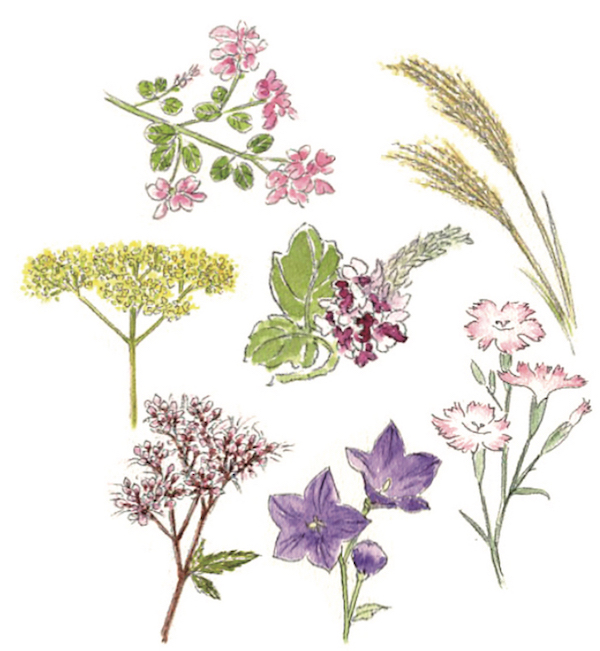
The Seven Herbs of Spring and Autumn
The expression, ‘the seven herbs’ doesn’t just refer to autumn flowers, though. There are also the ‘seven herbs of spring’. In fact (and not to detract from the popularity of Okura’s poem), the seven herbs of spring are even more well-known than those of autumn. So what are they? Seri (water dropwort), nazuna (shepherd’s purse), gogyō (cudweed), hakobera (chickweed), hotoke-no-za (nipplewort), suzuna (turnip) and suzushiro (daikon radish).
Hmm, turnip and daikon would be familiar to most, but the rest of these herbs aren’t the kind of thing you’d normally find in the supermarket, are they? And while the seven herbs of spring do flower, they’re certainly not flowering in mid-winter, which is the time that concerns us. Besides, their rather plain flowers are hardly the stuff of poetry. These are actually all edible plants though, the seven herbs that go into nanakusa-gayu, the rice porridge eaten on Jinjitsu-no-sekku (7 January), one of the five seasonal festivals of the old calendar and part of traditional New Year celebrations – and it’s worth remembering that New Year used to be sometime in late January to mid-February, so a lot closer to spring than it is in the modern calendar. Nanakusa-gayu has become so synonymous with this festival, that the day itself is more commonly referred to as Nanakusa-no-sekku.
The expression ‘nanakusa’ or ‘seven herbs’, then, refers to edible herbs in spring and flowers in autumn. Thinking back to Okura’s poem about the seven herbs and the line, ‘flowers blossoming in autumn fields’, it’s clearly the flowers he wants us to admire. So, what would you rather do? Admire them, or eat them? I’ll leave that up to you!
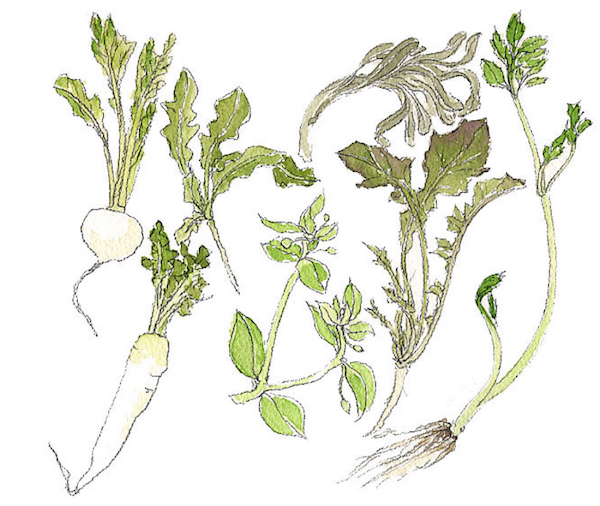
The Seven Flowers of Autumn and the Tanabata Festival
The section of the Man’yōshū that our poem comes from is a collection of verses about autumn. The poem just before Okura’s Nanakusa is also one of his and, oddly, is about Tanabata, the star festival when the stars, Vega (the weaver in Japan) and Altair (the cowherd), come together. The Nanakusa, or Seven Herbs of Autumn seems in some way to be just one part of a longer poem about Tanabata.
This is puzzling, because Tanabata is on July 7th, and there are certainly no autumn flowers blooming in July! Even more puzzling, in the old lunisolar calendar from the time this poem was written, autumn lasted from the seventh month until the ninth month. So July, which we all think of as mid-summer, would have been considered early autumn.
Really?
Actually, no. This only makes sense when you reconcile the old calendar with our modern-day calendar. The seventh month of the old calendar (what we now call July) sits over August and September in the modern calendar, so Tanabata, the festival of the seventh day of the seventh month, would have been celebrated in what is now mid to late August. It would still have been hot, but there would have been cooler autumn breezes in the mornings and evenings and the first of the autumn flowers would have been starting to bloom.
That solves the puzzle, then, of why Okura’s autumnal poem was part of a poem about what we now think of as a summer festival – Tanabata used to come at the beginning of autumn. Offerings of flowers were always made on the seasonal festivals, and this would have been the case with Tanabata, too. Nobody can say for sure which flowers were used to mark Tanabata, but it’s entirely possible that Okura’s Nanakusa was a list of seasonal autumn flowers that people used for offerings during this festival.
When we think about the origins of these traditions, it pays to remember that they were part of the old calendar. These days, July 7th is far from being autumnal – summer’s only just gaining momentum. And for me, rather than autumn flowers, Tanabata always conjures up the sights and sounds of the rainy season – and that fits too, since it’s traditionally the rain and clouds that prevent the celestial lovers from keeping their annual tryst. I imagine they would have had a much better time of it in the olden days, when Tanabata was in August and the weather was more settled!
It’s not only the calendar that has changed, either. In modern Japan, our connection with nature and the seasons is nothing like what it was back when people were more aware of the subtle changes of the seasons. Going by the old calendar, the seventh day of the seventh month would have fallen on August 28th last year (2017). Were any of the seven flowers of autumn in bloom then? I have to admit, I don’t recall noticing any myself, but I certainly hope there never comes a day when nobody can recall having seen a single one of Okura’s autumn flowers.



